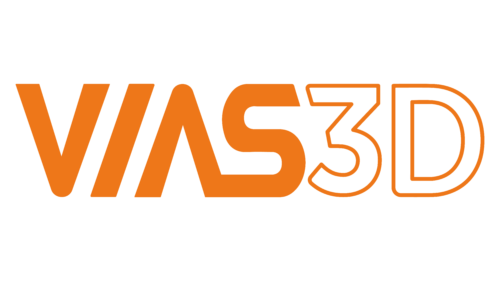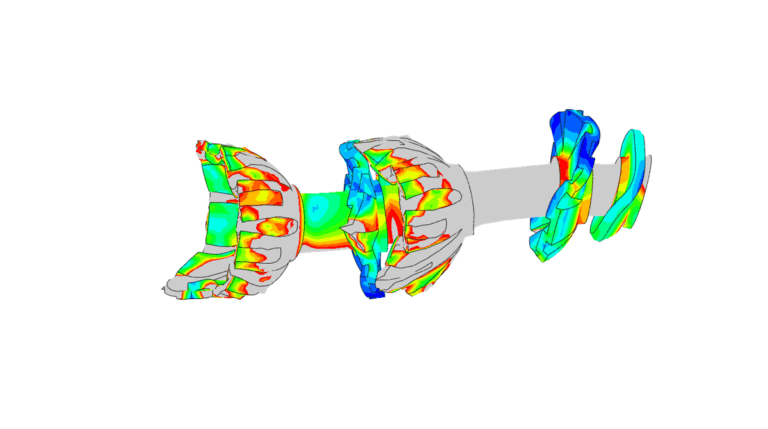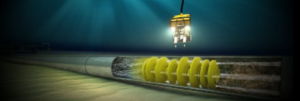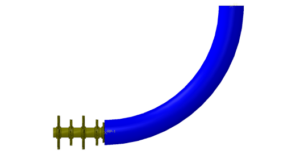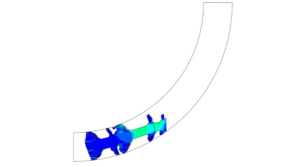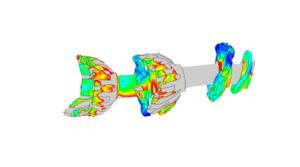Abaqus/CAE is a versatile nonlinear FEA software, that is used in various industries to perform highly complex simulations for design and analysis. Being a general-purpose software allows Abaqus to be used in a variety of industries, from oil and gas, to life sciences and automotive as well as aerospace. Simulation allows industries to reduce cost, perform virtual testing and bring an efficient design into the market, without expensive prototype testing and long times to setup such tests. This blog shows the application of Abaqus/CAE to FEA of a complex nonlinear problem of pipeline pigging.
What is Pigging?
Pigging is a method to inspect and maintain the condition of industrial pipes using the tool known as a pig.
Pigging plays a major role in two main functions for pipelines:
- They help to ensure continuous operation by removing any substance which might damage the pipeline process systems and help to prevent the formation of corrosion cells.
- They help to ensure maximum efficiency by removing any liquid or solid debris in the pipeline which might otherwise build up and restrict the flow.
Figure 1 shows a cutaway view of a subsea pipeline subjected to a pigging operation. This is an illustrative figure, showing how the pig moves through the pipeline.
Figure 1: Cutaway view of a subsea pipeline, showing the pigging operation
There are various configurations of pipeline pigs available, depending upon the application (whether it is inspection or cleaning). Some of the important pigging configurations used in the pipeline industry are foam pigs (made of polyurethane, used in soft applications), soluble pigs (made in the shape of sphere-shaped balls or cylinders, used to clean out paraffin deposits and other unwanted accumulations inside of pipes), steel body pigs (these pigs can travel long distances and the urethane cups and discs are replaceable which makes them an economical option for many pipeline operators), and disk shape pigs (made of polyurethane hyperelastic material, to clean out the pipes waxes, paraffins, etc in bent or Y-shaped pipe configurations).
Simulation of a Disk-Shaped Pipeline Pig
Simulation plays an important role in obtaining an optimal design for a pig and to optimize the material under different conditions.
Figure 2 shows a 3D model of a disk-shaped pig with spacers and shaft entering a 5D pipe bend. The model is developed using Abaqus/CAE and FEA is performed to demonstrate the stresses and deformations of the pig as it traverses the bend. Abaqus/Explicit is used to simulate the pig 3D nonlinear dynamic model. To reduce computational cost the pipe is assumed to be a rigid body. To model the rubber and elastic behavior of pig it is modeled as hyper elastic material. Self-contact between the pigging members and contact with the internal pipe surface is modeled. This dynamic model illustrates important features of a pigging process including contact, large deformation, kinematics, and stress on the pig. The key information obtained from the simulation can be used to design optimal pig.
Figure 2: Model of pigging operation in Abaqus/CAE, showing the pig and pipe.
Figure 3 shows the deformed pig shape as the pig traverses the bend and its disks deform to conform to the internal diameter of the pipe.
Figure 3: Pig inside the pipe.
Figure 4 shows the deformed shape of the pig. Notice the flower-petal pattern of the disks as they are deformed.
Figure 4: Deformed shape of the pig
A video illustrating the dynamic simulation of the pig in the model is shown here:
Using dynamic FEA simulation of pig moving through the pipeline, one can obtain displacement, stress, contact pressure, and velocity contours of the pig which are prime features to optimally design this component. Pigging analysis is a highly nonlinear problem due to contact (between pig and pipe), large deformation, and material nonlinearity (because of material flow behavior). So, the analysis of pigging operation requires a complex algorithm to guarantee robust solution.
Vias3D engineering and simulation team combines decades of analytical and design experience. They have successfully designed various products from many industries for strength, stability, rigidity, and fatigue endurance. Our design and analysis capabilities are accomplished through advanced engineering modeling techniques such as Finite Element Analysis (FEA) using Abaqus, Computational Fluid Dynamics (CFD), and other tools.
Using these advanced tools, we can capture complex design features and nonlinearities arising from materials, geometry, and surface interactions to simulate designs and predict their response before they are brought in production.
Please email me, Arindam Chakraborty, at [email protected].
Contributors:
Santosh Paudyal, MS, Engineering Intern at Vias3D. Mr. Santosh Paudyal is a mechanical engineer with more than 3 years of professional experience. He has valuable experience in supporting clients, designing, and implementing climate control systems, project management, and structure simulation using Simulia Abaqus. He holds a master’s degree in mechanical engineering from the University of North Dakota.
Syed Jafri, Ph.D., P.E., has about 14 years of experience in the use of nonlinear finite element analysis using Abaqus to analyze and design components from different industries such as oil and gas subsea infrastructure, medical and life sciences applications such as implanted knee components, and performing Level 3 fitness-for-service analyses for petrochemical industries. He also has expertise in rotordynamics and vibrations. He is working as Senior Simulation Consultant at Vias3D and can be reached at [email protected].
Arindam Chakraborty, Ph.D., PE (TX, CA) is a mechanical engineer with more than 14 years of strong academic and consulting experience in areas like solid and fracture mechanics and design, non-linear FEA, reliability, workflow automation. His experience spans industries like Nuclear, Oil & Gas, Petrochemical & Process Facilities, Life Science. Dr. Chakraborty has more than twenty five conference and journal publications and is closely involved with ASME and API technical groups.
Sources:
1] Xu, Xiao-Xuan, and Jing Gong. “Pigging simulation for horizontal gas-condensate pipelines with low-liquid loading.” Journal of Petroleum Science and Engineering 48.3-4 (2005): 272-280.
2] https://pipelineequipment.com/news/30/what-everyone-needs-to-know-about-building-pig-launchers,-receivers
3] https://www.hps-pigging.com/about-hps/what-is-pigging/
4]https://www.products.slb.com/resource-library/article/valve-academy/how-it-works-pipeline-pigging
5] http://ieomsociety.org/ieomdetroit/pdfs/343.pdf
6] https://www.drinkwaterproducts.com/
